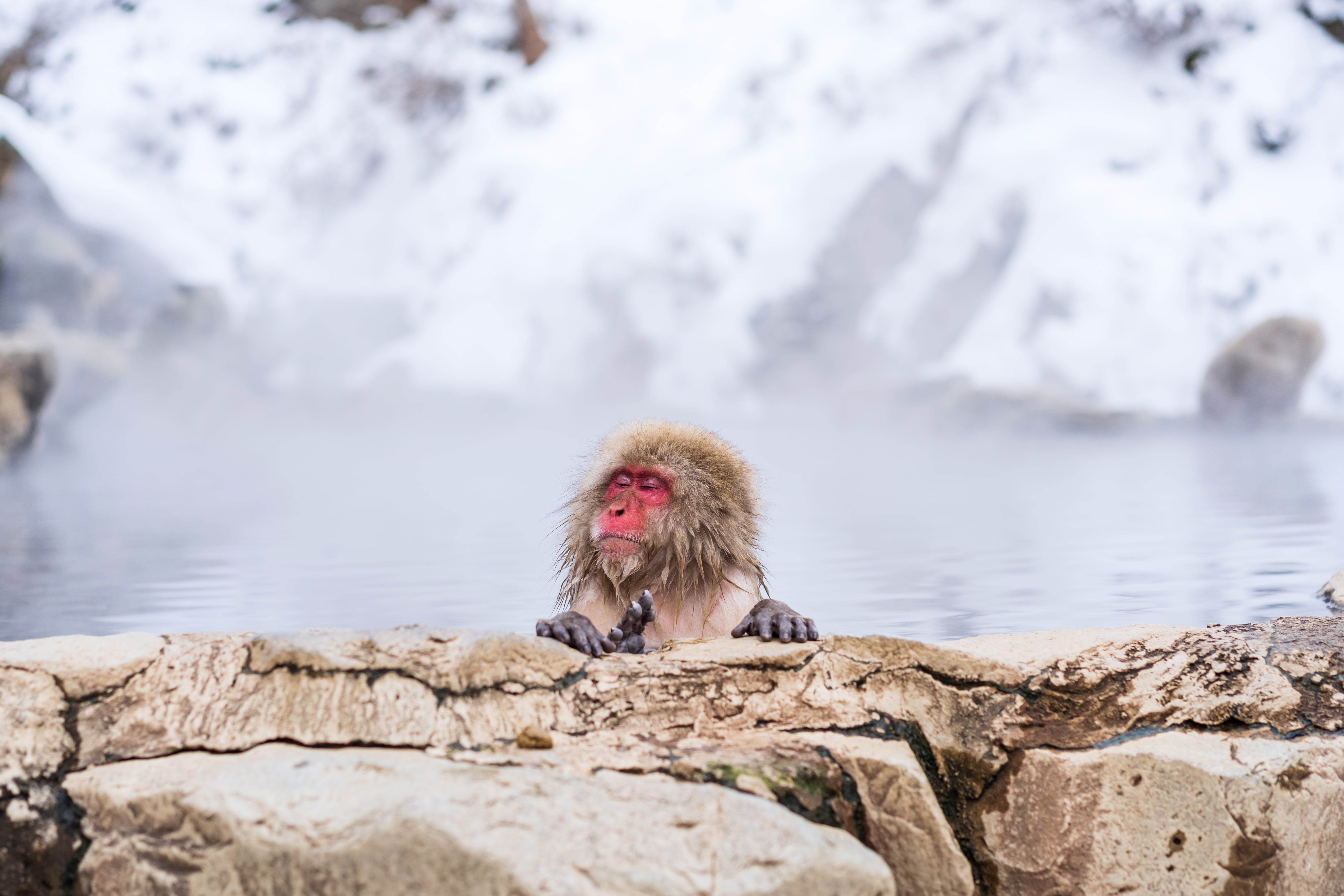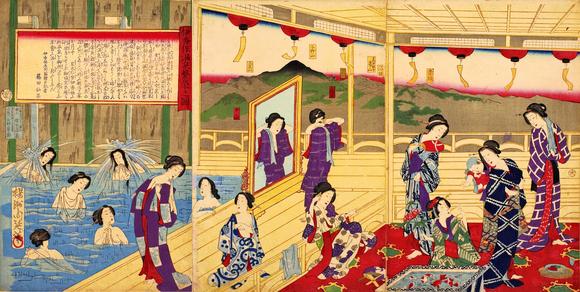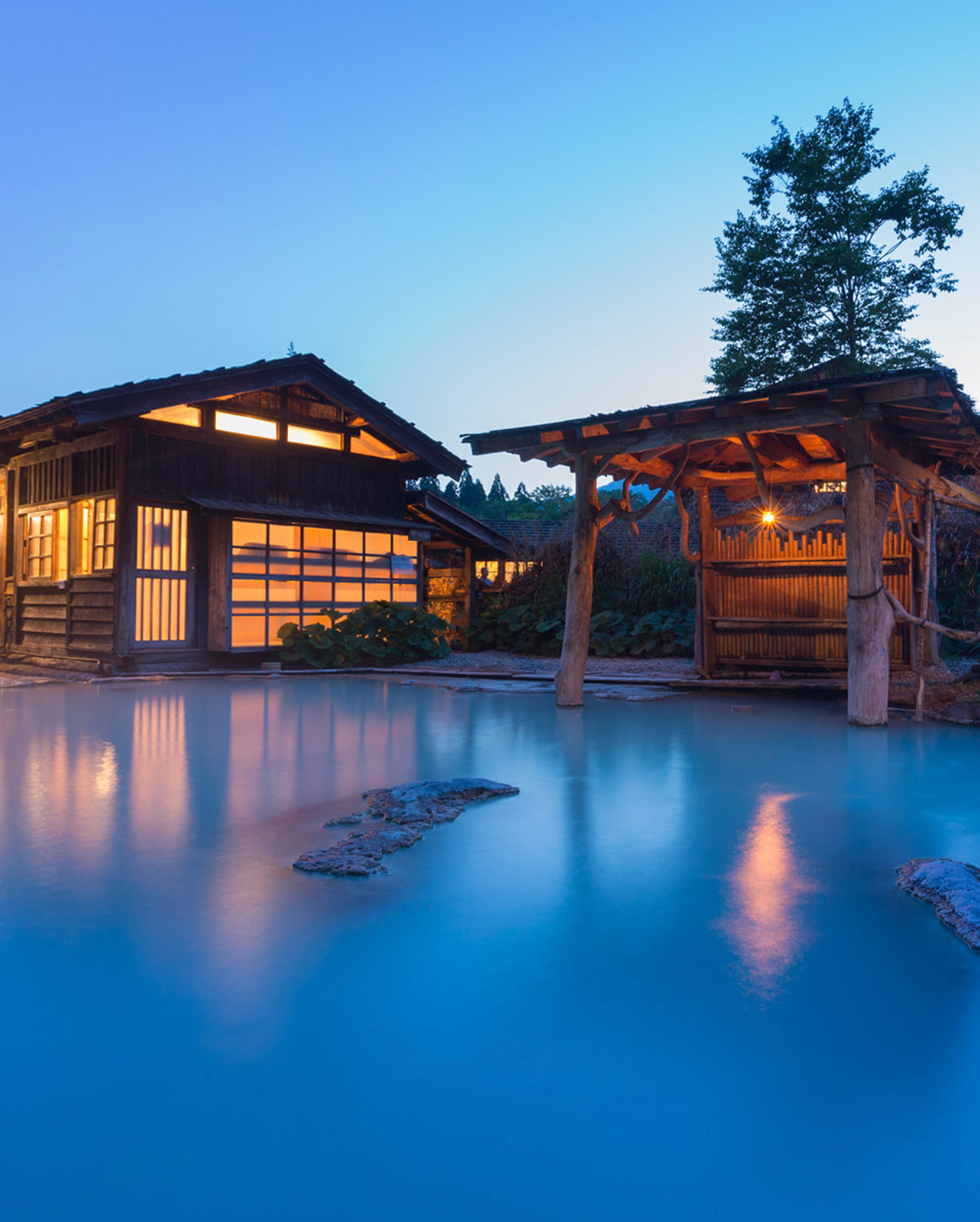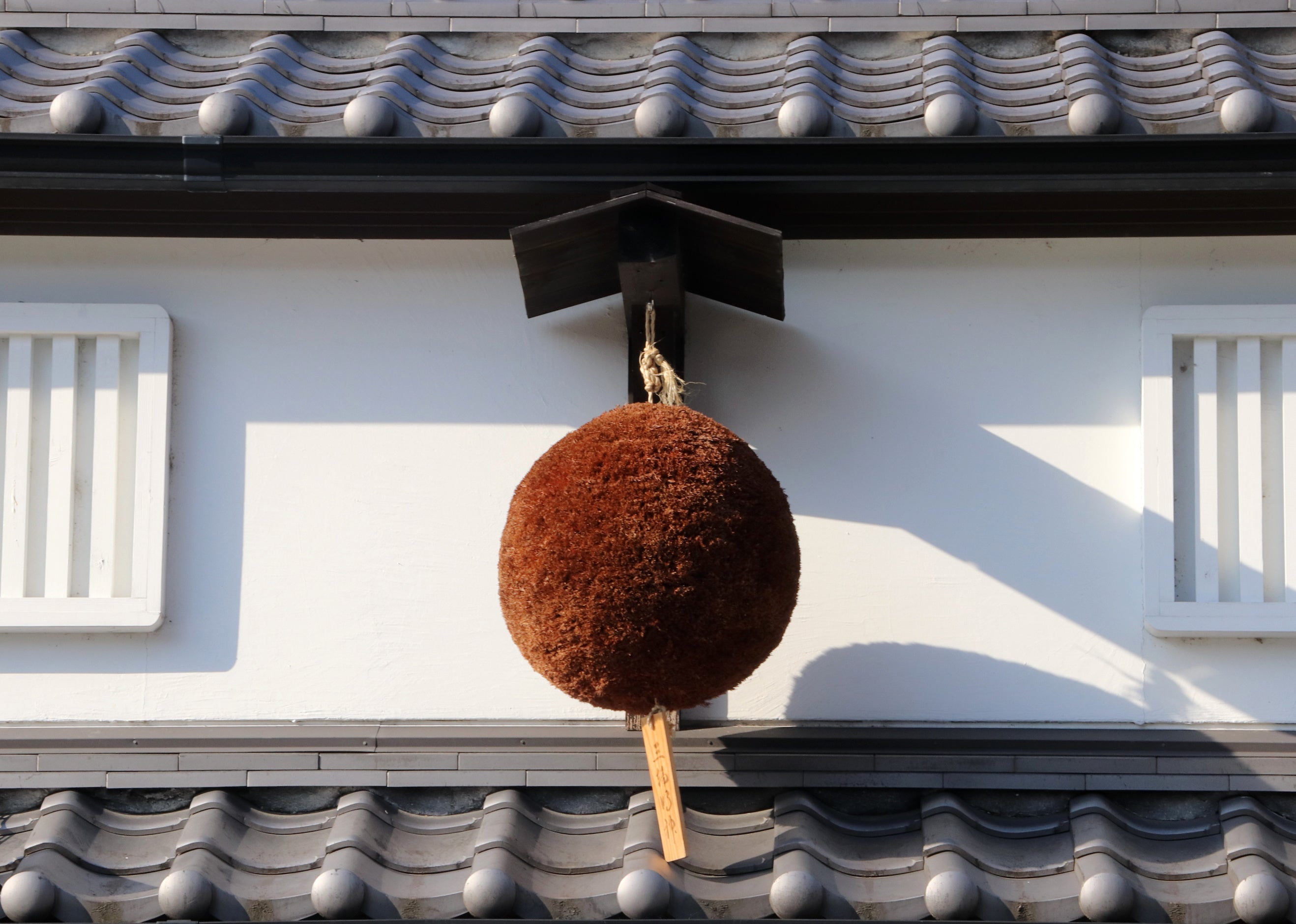The Different Types of Onsen You Need to Know About Before Your Next Trip to Japan
If you ever travel to Japan, there are certain things you must do: eat the freshest sushi you can find, drink locally made sake, climb Mt. Fuji, take a ride in the bullet train, etc. But many people tend to miss out on the most traditional and amazing Japanese experience there is: relaxing at an onsen.
Amidst snow sustaining temperatures,
people and beasts alike,
rest in steaming waters.
A Japanese Haiku Poem

What's an onsen?
The Onsen (温泉) refer to the Japanese spa facilities built around natural hot springs. Since Japan is a volcanic island, there are more naturally occurring hot springs than anywhere else in the world.
There are over 30,000 naturally occurring hot springs and 3,000 onsen resorts in Japan. For comparison, the US only has around 1,600 naturally occurring hot springs and less than 100 hot spring resort.
What makes an onsen experience so special is that it's rooted in thousands of years of Japanese culture and tradition and is considered one of the best ways to relax and take your mind off of things.

Table of Content
- Introduction
- Different Types of Onsen
- Difference Between Natural Onsen and Public Bath
- Benefits of Onsen
- How to Get the Onsen Experience at Home
- Free step-by-step guide

Different Types of Onsen
While there are many types of onsens, there are certain criterias in order for a hot spring to be considered an onsen.
Osens are defined as hot water that springs from the Earth, either naturally or from artificially bored holes.The onsen water needs to be higher than 25°C or 77°F.
It needs to have at least 1 of 19 different types of minerals. There are a total of 19 different types of baths, which are classified by their mineral composition. These minerals have long been regarded by the Japanese to aid in illness and injury.
The theory is that the minerals contained in the onsen water are absorbed through your skin into your body, to provide various medical benefits.
Per 1kg of water, there needs to be any of the following compounds that are naturally dissolved in the water for it to be classified as a naturally occuring onsen.
- at least 1000mg of any natural minerals (excluding those on this list) dissolved in the water
- Free carbonic acid (CO2) = 250mg or more
- Lithium ion = 1mg or more
- Strontium ion = 10mg or more
- Barium ion = 5mg or more
- Iron = 10mg or more
- Manganese = 10mg or more
- Hydrogen = 1mg or more
- Bromine = 5mg or more
- Iodine = 1mg or more
- Flouride = 2mg or more
- Hydrogen arsenate = 1.3mg or more
- Arsenite = 1mg or more
- Sulfur = 1mg or more
- Metaboric acid = 5mg or more
- Metasilicic acid = 50mg or more
- Bicarbonate soda = 340mg or more
- Radon = 20 (1/10,000,000,000 curie unit) or more
- Radium salt = 1/100million mg or more
What's the Difference Between Natural Onsen and Public Bath in Japan?
Onsens 温泉 are found across many parts of Japan.
In many parts of Japan, you'll also find public baths or sentō 銭湯.
What's the different between an onsen and sentō?
Water Source:
Onsen water sources are geothermally heated, mineral-rich springs that emerge from the ground. These springs are believed to have therapeutic properties due to the various minerals dissolved in the water.
Sentō are communal bathing facilities found throughout Japan. The water in these baths is usually regular heated tap water or occasionally mineral water, but it is not sourced from a natural hot spring. On rare occasions, some public baths import natural hot spring water by the truckload.

Water Quality and Temperature:
Onsen: The mineral composition of the water in natural onsens can vary significantly depending on the location, giving rise to different types of onsen, such as sulfur springs, iron-rich springs, etc. The water temperature can range from lukewarm to extremely hot. Onsens may mix or dilute the mineral rich water with other types of water.
Sentō: The water in regular public baths is heated to a comfortable bathing temperature, typically around 40-42 degrees Celsius (104-107 degrees Fahrenheit). It does not contain the natural minerals found in onsen water.
Location:
Onsen: Onsen are usually located in scenic and rural areas, such as mountainsides or near volcanoes, where the natural hot springs occur. Onsens need geothermal vents which are typically found in volcanically active areas (hence mountainsides). Though there are onsens that can be found near seasides.
Sentō: Public baths are found in both urban and rural areas throughout Japan. They are often more easily accessible than onsen and are commonly found in neighborhoods.

Surroundings and Ambiance:
Onsen: Many onsen resorts and facilities offer stunning natural surroundings and peaceful settings, enhancing the overall relaxation experience. Some onsen have both indoor and outdoor baths, allowing visitors to bathe while enjoying nature.
Onsens are also usually found in Ryokans (traditional Japanese inns). Although a few popular onsen towns (ie: Beppu and Kusatsu) have so much geothermal activity that there are free public onsen baths scattered throughout the town.
Sentō: Public baths are typically indoor facilities, and while they may be well-maintained and clean, they typically do not offer the same natural ambiance as onsen.
Most baths found in major cities such as Tokyo, Kyoto, Osaka are sentō public baths and not onsens.
What's the Health Benefit of Onsen?
Japanese onsens offer a range of benefits for both physical and mental well-being. The therapeutic effects of onsen baths are believed to be derived from the unique mineral composition of the hot spring water.
Some of the potential benefits of Japanese onsens include:
Carbonic acid:
Carbonic acid is a weak acid formed when carbon dioxide (CO2) dissolves in water.
In some spa treatments, carbon dioxide gas is used in a procedure called "carbon dioxide therapy" or "carboxytherapy." Studies have shown that the controlled introduction of carbon dioxide into the skin may help improve blood circulation, leading to better oxygen and nutrient supply to the treated areas.
Carbon dioxide therapy is also suggested to stimulate the production of collagen, a protein that plays a crucial role in maintaining skin's firmness and elasticity. Increased collagen levels can potentially lead to skin rejuvenation and a reduction in the appearance of fine lines and wrinkles.
Lithium ion:
There is some evidence to suggest that lithium may have anti-inflammatory effects.
In dermatology, lithium has been used topically in certain formulations to treat acne. It helps reduce the activity of sebaceous glands, which are responsible for producing excess oil and can contribute to acne formation.
Strontium ion:
Strontium ions have been investigated for their ability to improve the skin's barrier which helps retain moisture, prevents water loss, and protects the skin from environmental irritants and allergens.
Strontium ions have also been shown to possess anti-inflammatory properties. This makes them potentially useful in calming and soothing inflamed and irritated skin, especially in conditions like eczema, rosacea, and contact dermatitis. Additionally, strontium ions may help reduce skin itching and sensitivity.
Some studies suggest that strontium ions could have an inhibitory effect on the enzyme tyrosinase, which plays a role in melanin production. This property might make strontium ions helpful in managing hyperpigmentation issues like melasma or age spots.
Iron:
Iron helps maintain healthy skin by supporting oxygen supply to skin cells. Proper oxygenation is essential for cell renewal and repair, resulting in a glowing complexion.
Adequate iron levels are essential for proper wound healing. It supports the formation of collagen, a protein crucial for tissue repair and regeneration.
Ensuring sufficient iron intake can also help maintain a healthy skin tone.
Shibukawa Ikaho Onsen in Gunma Prefecture is one of Japan's most famous, yet off the beaten path iron onsen.
Manganese:
Manganese is an essential trace mineral that plays several important roles in the body, contributing to overall health and potentially offering skin benefits as well.
Manganese is a component of the antioxidant enzyme superoxide dismutase (SOD). SOD helps neutralize harmful free radicals in the body, which can cause cellular damage and contribute to various chronic diseases.
Manganese is also essential for the synthesis of collagen, and improves skin elasticity and firmness. Adequate manganese levels can contribute to healthy, youthful-looking skin.
Iodine:
Iodine is an essential trace element that is critical for overall wellbeing and skin health.
Iodine has antiseptic properties, and it has been used as a topical disinfectant for wound care to prevent infections and promote healing.
It is also used for treating mild to moderate acne due to their antimicrobial properties, which can help reduce the bacteria that contribute to acne formation.
Iodine can also be beneficial for individuals with dry or flaky skin due to its potential to support healthy thyroid function and, in turn, maintain proper skin hydration.
Sulfur:
Sulfur has been used for centuries in various skincare products and treatments due to its therapeutic properties.
Sulfur is widely used in acne treatments. It has antimicrobial properties that help kill acne-causing bacteria and reduce inflammation associated with acne breakouts.
Sulfur can also act as a mild exfoliant, helping to remove dead skin cells and promote cell turnover.
Similarly, sulfur helps regulate the production of sebum, the skin's natural oil. Balancing sebum production can be beneficial for individuals with oily or acne-prone skin.
It can also help soothe and calm inflamed skin, making it useful for conditions like eczema, psoriasis, and rosacea.
Sulfur also softens and breaks down keratin, a protein that can contribute to the formation of certain skin conditions like keratosis pilaris (small bumps on the skin).
And lastly, sulfur can be effective in combating fungal infections, such as tinea versicolor and athlete's foot.
Takayu Onsen in Fukushima is a small onsen town that's famous amongst local Japanese for its sulfur onsen. If you are a skier/snowboarder then Zao Onsen is the place to go.
Metasilicic Acid:
Metasilicic acid, also known as orthosilicic acid, is a form of silicon dioxide (silica) that is found in natural waters and certain plant-based foods.
Silicon is believed to support the synthesis of collagen, improving the skin's elasticity and youthful appearance.
Adequate silicon intake may help promote healthy skin texture and reduce the appearance of fine lines and wrinkles.
Some research also suggests that it may help improve skin hydration by supporting the skin's barrier function, thereby reducing moisture loss.
Tamago-yu Onsen in Fukushima is known for their metasilicic onsen.
Bicarbonate Soda:
Also known as baking soda or sodium bicarbonate, has a fine, gritty texture that can serve as a gentle physical exfoliant, helping to remove dead skin cells and promote a smoother complexion.
Bicarbonate soda can also neutralize odors, making it useful as a natural deodorant for underarms or as an ingredient in foot soaks to combat foot odor.
It also acts as a mild antiseptic and has been shown to be helpful in reducing inflammation and controlling acne breakouts.
Bicarbonate soda can also provide relief from mild itching, such as insect bites, rashes, or skin irritation.
Sansuikan Onsen right outside of Osaka is a must visit beautiful onsen if you want to experience the alkaline bicarbonate soda onsen.
Radon & Radium salt:
Radium springs are rarer and usually pricier. Radium Springs are slightly radioactive but on a miniscule levels. The Misasa onsen is home to several natural radon springs.
It is thought that the radiation stimulates cells throughout the body and activates its function in what's called "hormesis effect". Hormesis is a biological phenomenon in which exposure to low doses of a potentially harmful substance or stressor results in a favorable response or beneficial effect.
In other words, small amounts of a toxin or stressor that would be harmful at higher levels can have a positive impact on your health and resilience when present in lower concentrations.
Can You Get the Onsen Experience at Home?
To get the real onsen experience, you have to go Japan. However getting a flight to Japan can cost $1000 and then booking a traditional ryokan hotel with an onsen could cost an additional $150 per person per night. 🥲
While we recommend everyone at least experience a traditional onsen at least once, we know that it's a tall order for many.
So if you want an at home onsen experience at home, you can definitely get an onsen bath bomb from Japan.
But did you know that there's an even better, more scientifically proven way to get better skin that's been used in Japan for over a thousand years?
Rice: The Timeless Secret to Glowing Skin in Japan
Ever since Japan's Heian period in 794 AD, rice has served as a nourishing secret in skincare, its magic further captured by the beauty brand SK-II in the 1970s.
And did you know that in Japan, the sake brew master (Toji) is known to have the most youthful skin? This is because they dip their hands in fermented rice everyday and fermented rice is known to have over 100 skin-loving nutrients! 💯
Read all about the magic of fermented rice and the amazing skin benefits here.
Why not experience the Toji sake brewer's secret to radiant skin everytime you shower! 🚿
INÉ Skin Nutrient Bar: Your Key to Unlocking the Ageless Beauty of Fermented Rice Water!

Introducing the INÉ Skin Nutrient Bar
An Artisan Soap Bar Made with Japanese Sake
Immerse yourself in the transformative power of fermented rice with the Skin Nutrient Bar, meticulously crafted with 100% organic Sake Kasu, a legendary secret from ancient Japanese skincare rituals.
Each bar, lovingly crafted to preserve the full, potent benefits of Sake Kasu, is designed to cleanse, nourish, and rejuvenate your skin from head to toe—all in the meditative mist of your shower. Just as the Toji's hands glow from daily immersion in sake, your skin too can embrace the radiant benefits of sake.
- Free from Harmful Additives
- Vegan Friendly
- Non-Comedogenic
- Safe For All Skin Types
- No Artificial Coloring or Fragrance
People Also Read

The Ultimate Guide to the Magic of Rice-Derived Skincare
In-depth research of all the beneficial compounds found in rice and the history of how rice has been used for skincare for generations.

How Japanese Minimalism Can Help Simplify Your Skincare Routine
Transformative Benefits of the Japanese Minimalist Skincare Approach for Healthier Skin and a Happier Life

Discover the Ancient Japanese Secret to Flawless Skin with Sake
How Sake Can Help You Achieve a Healthy and Glowing Skin Naturally
